Dupa plasarea solicitării de comandă, in sectiunea Istoric puteti vedea cate solicitări de comandă mai avem de procesat inaintea dumneavoastra
Program de lucru: Luni - Vineri 9:00 - 18:00, pauza 13:00 - 14:00.
Se efectueaza lucrari de mentenanta la site si pot aparea erori. In cazul in care intampinati erori va rugam sa reincercati mai tarziu.
Ridicarea personala este disponibila pentru comenzile achitate in avans. Se pot ridica dupa ce sunt pregatite.
No products
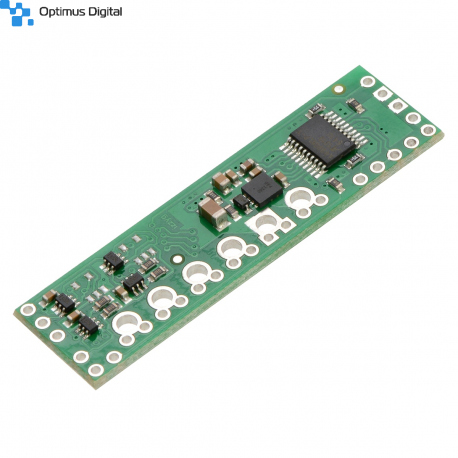 View larger
View larger
A4990 Dual Motor Driver Shield for Arduino
2512
New product
This small shield is an easy, economical way to control two small brushed DC motors with an Arduino or Arduino-compatible board. Its integrated A4990 dual motor driver operates from 6 V to 32 V and can deliver a continuous 0.65 A to each motor channel, making it a great control option for low-current motors that run on high voltages. The A4990 is configured to limit the peak motor current to about 0.9 A per channel and is protected against reverse-voltage, under-voltage, over-voltage, short-circuit, and over-temperature conditions.
See description for more details about the product.
Add to cart now!
This product is no longer in stock
- Write a review
- Remove this product from my favorite's list.
- Add this product to my list of favorites.
More info
Overview
This motor driver shield and its corresponding Arduino library make it easy to control a pair of bidirectional, brushed DC motors with an Arduino or compatible board, such as the A-Star 32U4 Prime. The board features Allegro’s A4990 dual H-bridge motor driver IC, which operates from 6 V to 32 V. It can deliver a continuous 0.65 A to each motor channel, and the current control feature of the A4990 limits the peak motor current to about 0.9 A per channel with the onboard sense resistors, making this shield well suited for low-current, high-voltage motors.
The shield ships fully populated with its SMD components, including the A4990 driver and a FET for reverse battery protection; header pins for interfacing with an Arduino and terminal blocks for connecting motors and power are included but are not soldered in (see the Assembly with included hardware section below).
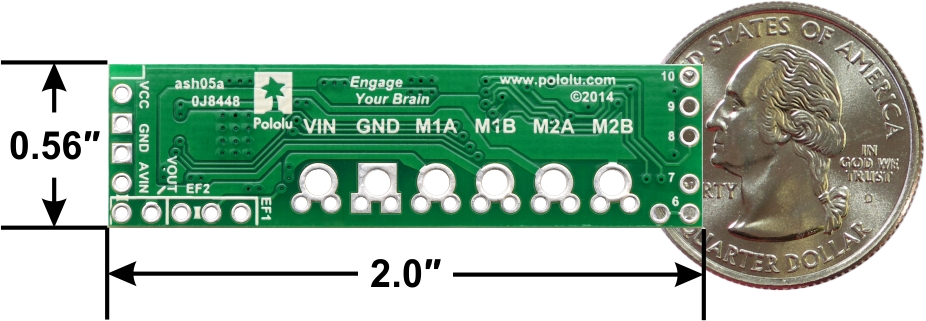
Pololu A4990 Dual Motor Driver Shield for Arduino, top view with dimensions.
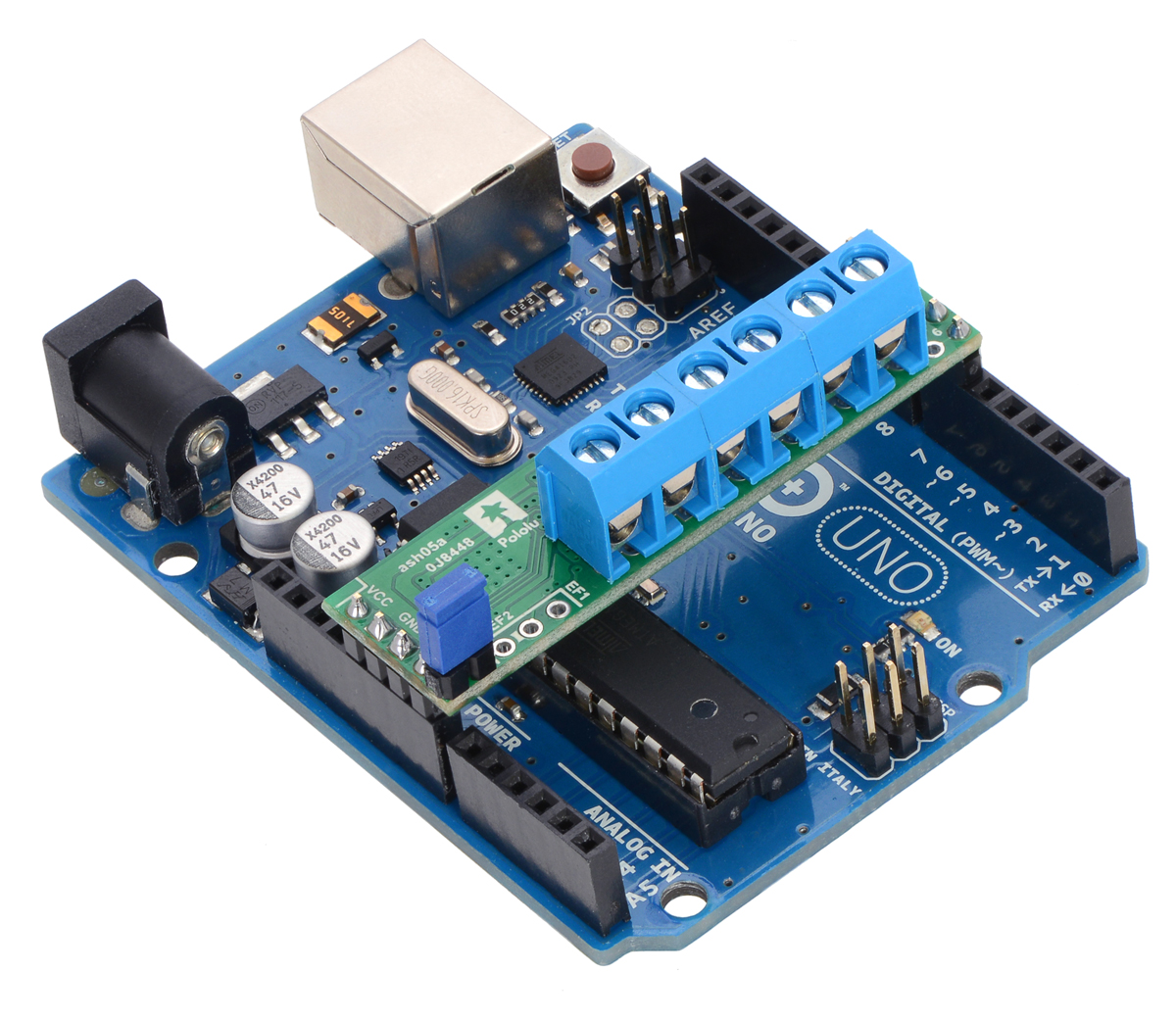
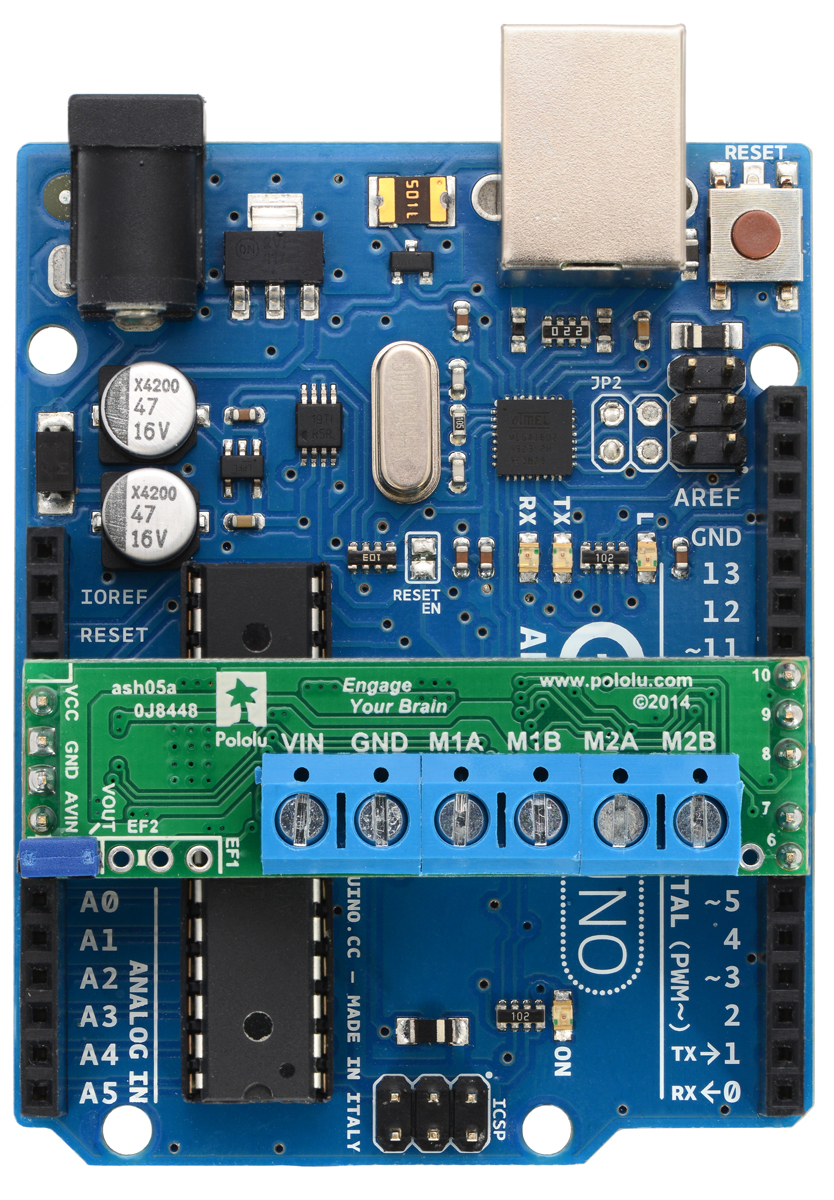
The shield uses digital pins 6, 7, 8, 9, and 10 for its diagnostic and control lines. It should be compatible with any board that has a standard Arduino pin arrangement and the ability to generate PWM signals on pins 9 and 10. Compatible control boards include:
● A-Star 32U4 Prime
● Arduino Uno
● Arduino Leonardo
● Arduino Due
● Arduino Mega 2560
This shield is intended to provide a low-cost, basic motor driver option for Arduinos, so it is much smaller than typical Arduino shields and does not include pass-through, stackable headers. For higher-power drivers with more configuration options, see the larger MC33926 and our VNH5019 motor driver shields.
For higher-current alternatives to this shield, please consider the dual MAX14870 motor driver shield or DRV8835 dual motor driver shield. We also have a smaller A4990 carrier for those using something other than an Arduino or with tighter space constraints.
Features
● Dual-H-bridge motor driver: can drive two DC motors or one bipolar stepper motor
● Motor supply voltage: 6 V to 32 V
● Logic supply voltage 2.5 V to 5.5 V
● Output current: 0.65 A continuous per motor
● Current control limits peak current to 0.9 A per motor
● Can work with ultrasonic (> 20 kHz) PWM frequencies, which allows for quieter motor operation
● Shield can optionally power the Arduino base directly when motor supply voltage is suitable
● Arduino library makes it easy to get started using this board as a motor driver shield
● Robust:
○ Reverse-voltage protection on the motor power supply
○ Can survive input voltages up to 40 V
○ Under-voltage and over-voltage protection
○ Over-temperature protection
○ Short-to-supply, short-to-ground, and shorted-load protection on the motor outputs
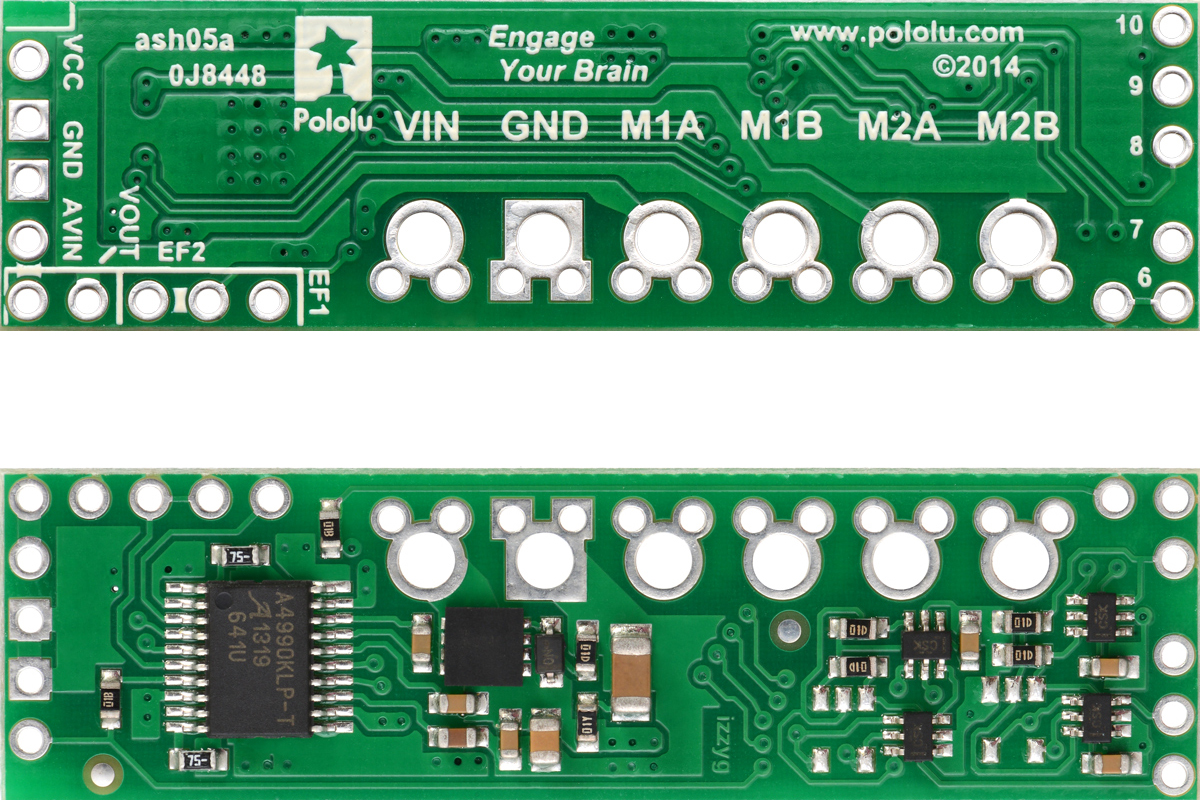
Pololu A4990 Dual Motor Driver Shield for Arduino, top and bottom sides.
Using the shield
The shield plugs into Arduino digital pins 6, 7, 8, 9, and 10 on one side and Arduino VIN, GND, GND, and 5V/VCC on the other. The upper-left corner of the shield partially blocks the Arduino’s 3.3V pin, but this region of the board (marked with a white silkscreen box) can be removed if necessary to allow access.
In the shield’s default state, the motor driver shield and Arduino are powered separately, though they share a common ground and the Arduino’s 5V rail serves as the shield’s logic supply. When used this way, the Arduino must be powered via USB, its power jack, or its VIN pin, and the shield must be supplied with 6 V to 32 V through its large VIN and GND pads. Attempting to power the shield from the Arduino is not recommended as this could result in large currents flowing through small traces. However, if the motor power supply is suitable, it is possible to power the Arduino from the shield. This can be accomplished by placing a jumper between the shield pins in the lower-left corner labeled VOUT and AVIN, which connects the reverse-protected motor supply voltage to the Arduino’s VIN pin to power the Arduino. The Arduino’s power jack must remain disconnected at all times in this configuration.
Warning: When powering the Arduino from the motor shield, you must never connect a different power supply to the Arduino’s VIN pin or plug a power supply into the Arduino’s power jack, as doing so will create a short between the shield’s power supply and the Arduino’s power supply that could permanently damage both the Arduino and the motor shield. In this case, it is also important that your shield power supply is an acceptable voltage for your Arduino, so the full shield operating voltage range of 6 V to 32 V probably will not be available. For example, the recommended operating voltage of the Arduino Uno is 7 - 12 V.
The shield has integrated logic gates that simplify the control interface of the A4990 by reducing the number of PWM signals required. Each channel has a speed control input, MxPWM, and a direction control input, MxDIR. Arduino pins 9 and 7 are used to control the speed and direction, respectively, of motor 1, and pins 10 and 8 control the speed and direction of motor 2. The following truth table shows how the shield operates:
| MxDIR | MxPWM | MxA | MxB | operating mode |
| 0 | PWM | PWM | L | forward/brake at speed PWM % |
| 1 | PWM | L | PWM | reverse/brake at speed PWM % |
| X | 0 | L | L | brake low (outputs shorted to ground) |
The A4990 has two diagnostic pins, EF1 and EF2, that offer feedback about the state of the driver. These pins are open-drain outputs that are driven low by the chip to indicate faults (the datasheet describes what each combination of EF1 and EF2 means). Otherwise, these pins remain in a floating state. By default, EF2 is connected to Arduino digital pin 6 through a 1 kΩ protection resistor; with pin 6 configured as an input with its internal pull-up enabled, a low signal indicates an over-current, over-voltage, or over-temperature condition.
The EF1 and EF2 pins can more generally accessed via the 3-pin row of through-holes in the lower-left corner of the board. If you do not want to monitor the motor driver fault flags or would rather free up pin 6 for some other purpose, you can cut the trace that connects the EF2 pin to its neighboring (center) pin on the bottom side of the shield.
Current limiting
The A4990 can actively limit the current through the motors by using a fixed-frequency PWM current regulation (current chopping). This carrier board connects 0.075 Ω resistors to the current sense pins, which sets the current limit to a nominal 1 A per channel. In our tests, the board actually limited the motor current to slightly above 0.9 A.
Real-world power dissipation considerations
Even though the driver limits the motor current to about 0.9 A per channel, the chip by itself will overheat at lower currents. For example, in our tests at room temperature with no forced air flow, the chip was able to deliver 0.9 A per channel for approximately 15 seconds before the chip’s thermal protection kicked in. A continuous current of 0.65 A per channel was sustainable for many minutes without triggering a thermal shutdown. The actual current you can deliver will depend on how well you can keep the motor driver cool. Our tests were conducted at 100% duty cycle; PWMing the inputs will introduce additional heating proportional to the frequency (unless the A4990 is already PWMing the outputs to limit the current).
This product can get hot enough to burn you long before the chip overheats. Take care when handling this product and other components connected to it.
Schematic diagram
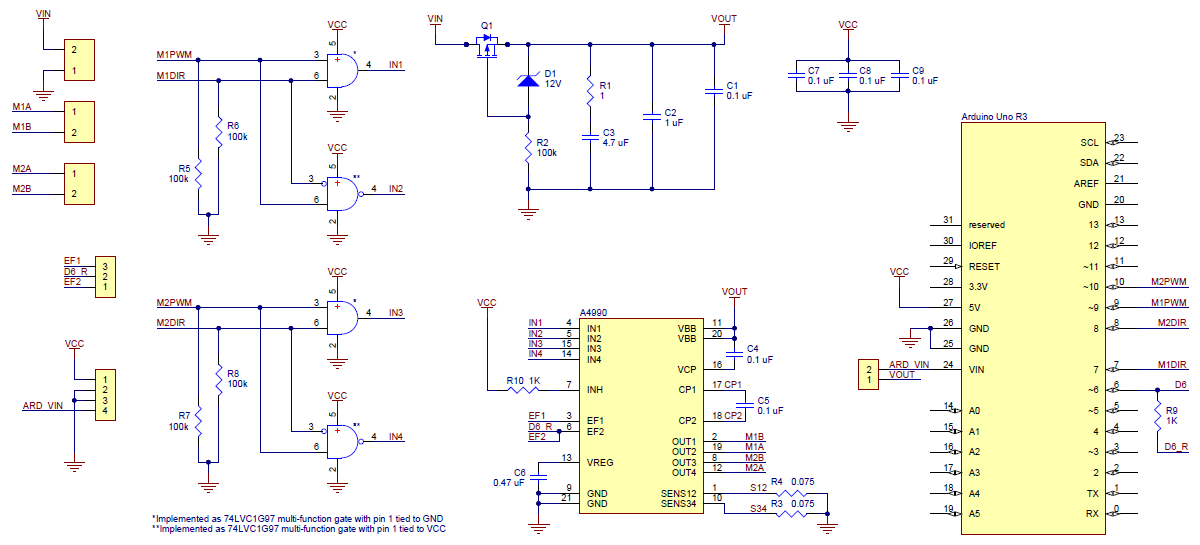
Pololu A4990 Dual Motor Driver Shield for Arduino schematic diagram.
This schematic is also available as a downloadable pdf (268k PDF).
Specifications
Dimensions
| Size: | 2.0" x 0.56"1 |
| Weight: | 2.5 g1 |
General specifications
| Motor driver: | A4990 |
| Motor channels: | 2 |
| Minimum operating voltage: | 6 V |
| Maximum operating voltage: | 32 V2 |
| Continuous output current per channel: | 0.65 A3 |
| Peak output current per channel: | 0.9 A4 |
| Reverse voltage protection?: | Y |
Notes:
1 Without included hardware.
2 Over-voltage protection typically activates at 34 V, but it can trigger at voltages as low as 32 V.
3 Typical results with 100% duty cycle at room temperature.
4 Current is automatically limited to this by the driver; determined by onboard sense resistors.
Don't delay. Buy today.
Add to cart now!
Reviews
Customers who bought this product also bought:
-
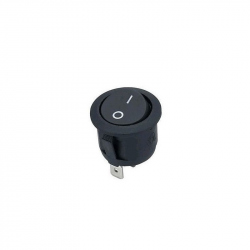
Round Button
Round Button See description for more details...
$0.33
-
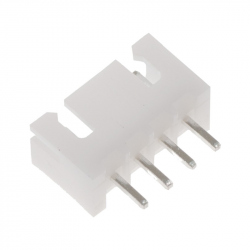
PH2.0 Socket 4p
PH2.0 Socket 4p
$0.12
-
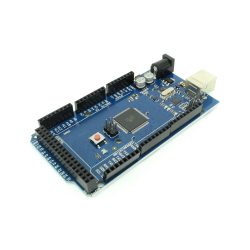
Development...
Development Board Compatible with Arduino MEGA...
$22.17
-
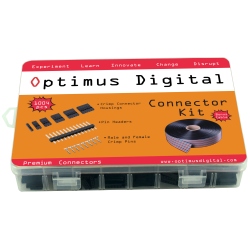
Connector...
Complete Connector Kit: single row pin...
$14.40
-
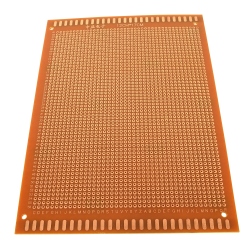
Test Wiring...
Test Wiring 180 x 300 mm
$6.00
-
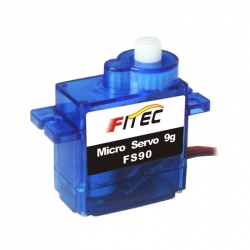
FS90 Micro...
FS90 Micro Servomotor with Plastic Reducer See...
$6.48
-

SYB-170...
Colored mini breadboard, ideal for small...
$0.57
-
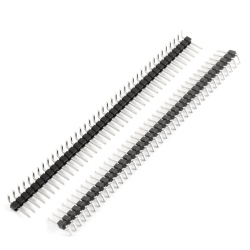
90° 2.54 mm...
These 1 x 40 right angle male pin headers are...
$0.36
-
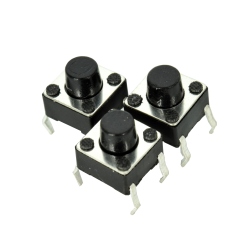
6 x 6 x 6...
This mini momentary tactile switch can be used...
$0.09
-
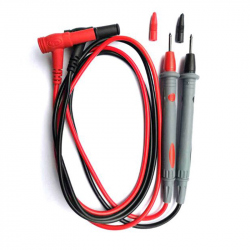
Professional...
Professional Multimeter Testers
$3.60




